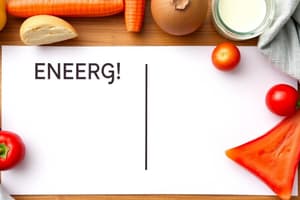Podcast
Questions and Answers
What are the primary reasons for eating food?
What are the primary reasons for eating food?
- To regulate blood sugar levels
- To consume fiber and water
- To intake only vitamins and minerals
- To obtain energy and support body functions (correct)
Which macronutrient provides the highest energy per gram?
Which macronutrient provides the highest energy per gram?
- Protein
- Fat (correct)
- Fiber
- Carbohydrate
What unit is used to measure food energy?
What unit is used to measure food energy?
- Kilojoules and kilocalories (correct)
- Milligrams
- Liters
- Grams
What role do vitamins and minerals play in nutrition?
What role do vitamins and minerals play in nutrition?
How should individuals balance their energy intake?
How should individuals balance their energy intake?
What is the equivalent of 1 kilocalorie in kilojoules?
What is the equivalent of 1 kilocalorie in kilojoules?
Which of the following substances does NOT provide energy?
Which of the following substances does NOT provide energy?
What should constitute a healthy diet?
What should constitute a healthy diet?
What are the two components of the energy cost of lactation?
What are the two components of the energy cost of lactation?
How does basal metabolic rate (BMR) change with age?
How does basal metabolic rate (BMR) change with age?
Which statement is true regarding sex differences in energy requirements?
Which statement is true regarding sex differences in energy requirements?
What defines the nutritional requirement for a nutrient?
What defines the nutritional requirement for a nutrient?
What does the Estimated Average Requirement (EAR) represent?
What does the Estimated Average Requirement (EAR) represent?
Which of the following is a component of Dietary Reference Intakes (DRI)?
Which of the following is a component of Dietary Reference Intakes (DRI)?
The Recommended Dietary Allowance (RDA) is intended to meet the requirements of which percentage of individuals?
The Recommended Dietary Allowance (RDA) is intended to meet the requirements of which percentage of individuals?
What does a lower reference nutrient intake (LRNI) indicate?
What does a lower reference nutrient intake (LRNI) indicate?
What is the expected weight gain for a well-nourished woman during pregnancy?
What is the expected weight gain for a well-nourished woman during pregnancy?
During which trimesters is the weight gain for the fetus particularly slow and anabolic for the mother?
During which trimesters is the weight gain for the fetus particularly slow and anabolic for the mother?
What percentage of the weight gain during pregnancy is attributed to maternal factors such as fluid volume, protein, and fat deposition?
What percentage of the weight gain during pregnancy is attributed to maternal factors such as fluid volume, protein, and fat deposition?
What happens to the mother's fat stores during the later trimester if her caloric intake is insufficient?
What happens to the mother's fat stores during the later trimester if her caloric intake is insufficient?
What are the potential negative outcomes of pregnancy associated with poorly nourished women?
What are the potential negative outcomes of pregnancy associated with poorly nourished women?
What is the purpose of establishing the Lower Reference Nutrient Intake (LRNI)?
What is the purpose of establishing the Lower Reference Nutrient Intake (LRNI)?
What does the Adequate Intake (AI) level indicate?
What does the Adequate Intake (AI) level indicate?
What percentage of healthy individuals does the Upper Tolerable Intake Level (UL) account for?
What percentage of healthy individuals does the Upper Tolerable Intake Level (UL) account for?
Which of these nutrients has the highest Upper Intake Level (UL)?
Which of these nutrients has the highest Upper Intake Level (UL)?
Which method is NOT used for establishing Dietary Reference Intakes (DRIs)?
Which method is NOT used for establishing Dietary Reference Intakes (DRIs)?
What does the Estimated Energy Requirement (EER) take into consideration?
What does the Estimated Energy Requirement (EER) take into consideration?
During which critical period is there a significant increase in nutrient requirement?
During which critical period is there a significant increase in nutrient requirement?
What is an important factor influencing prenatal nutrition?
What is an important factor influencing prenatal nutrition?
What is the relationship between increased energy requirements and pregnancy?
What is the relationship between increased energy requirements and pregnancy?
Which physical activity multiplier corresponds to a very active woman?
Which physical activity multiplier corresponds to a very active woman?
Which of the following is a primary component of energy requirements?
Which of the following is a primary component of energy requirements?
What does energy balance refer to?
What does energy balance refer to?
Which stage of life requires additional energy for growth and development?
Which stage of life requires additional energy for growth and development?
What is necessary for the metabolic response to food?
What is necessary for the metabolic response to food?
Which energy requirement component is influenced most by exercise?
Which energy requirement component is influenced most by exercise?
What is one of the energy costs associated with pregnancy?
What is one of the energy costs associated with pregnancy?
What contributes to the energy cost of lactation?
What contributes to the energy cost of lactation?
Which of the following is NOT a component of energy requirements?
Which of the following is NOT a component of energy requirements?
Flashcards are hidden until you start studying
Study Notes
Nutritional Requirements
- Your body needs energy and compounds for growth, repair, and reproduction
- Energy is measured in kilojoules (kJ) and kilocalories (kcal)
- 1 gram of protein provides 4 kcal
- 1 gram of carbohydrate provides 4 kcal
- 1 gram of fat provides 9 kcal
- A healthy diet should fulfill energy needs, provide essential nutrients, reduce disease risk, and be safe to consume.
Energy Requirements
- Human energy requirements are estimated based on energy expenditure, growth, pregnancy, and lactation.
- Energy balance is achieved when energy intake is equal to energy expenditure.
Components of Energy Requirements
- Basal metabolism: Essential bodily functions like cell function, enzyme production, hormone secretion, protein transport, temperature maintenance, and organ function.
- Metabolic response to food: Energy required for food ingestion, digestion, absorption, and nutrient transport.
- Physical activity: The most variable component of energy expenditure.
- Growth: Energy needed for tissue synthesis and deposition.
- Pregnancy: Energy for fetal growth, placenta development, and maternal tissue growth.
- Lactation: Energy for milk production and secretion.
Changes in Energy Requirements
- Age: Basal metabolic rate (BMR) is higher in childhood and adolescence and lower in old age.
- Sex: Men generally have higher muscle mass, leading to higher BMR per unit body weight compared to women.
Nutritional Requirements
- Dietary Reference Intakes (DRIs): Quantitative estimates of nutrient intake for healthy people.
- Estimated Average Requirement (EAR): Average nutrient requirement for 50% of the population.
- Recommended Dietary Allowance (RDA): Daily intake that meets the requirements of 97.5% of healthy individuals.
- Lower Reference Nutrient Intake (LRNI): Nutrient amount sufficient for only 2.5% of the population.
- Adequate Intake (AI): Estimated nutrient intake based on observations of healthy individuals; no risk of deficiency at this level.
- Tolerable Upper Intake Level (UL): Maximum intake from food that is unlikely to pose health risks for most people.
Determining Energy Needs
- Estimated Energy Requirement (EER): Average dietary energy intake that maintains energy balance.
- EER is determined by age, sex, weight, height, and physical activity level.
Nutritional Requirements During Critical Periods
- Specific nutrient needs exist during pregnancy, lactation, infancy, adolescence, and old age.
- These groups are more vulnerable to malnutrition due to inadequate intake and special requirements.
Pregnancy
- Pregnancy is considered physiological if mothers produce a healthy baby, sufficient and high-quality breast milk, and their own health is not compromised.
- Prenatal nutrition is influenced by pre-pregnancy nutritional status, maternal age, and parity (number of previous pregnancies).
- Increased energy and nutrient requirements during pregnancy are needed for tissue formation (placenta, fetus, amniotic fluid), tissue growth (uterus, blood volume, breasts, fat), and increased BMR.
- Inadequate nutrition during pregnancy can lead to negative outcomes such as abortions, stillbirths, fetal malformations, morbidity and mortality, and impaired fetal growth and development.
- Weight gain during pregnancy is essential for fetal well-being.
- A well-nourished woman should gain approximately 20% of her pre-pregnancy weight during pregnancy (11-16 kg).
- Weight gain during pregnancy is distributed between maternal tissue (60%) and fetal development (40%).
Recommended Weight Gain During Pregnancy Based on Pre-Pregnancy Weight
- Underweight (BMI < 18.5), should gain 12.5-18 kg
- Normal weight (BMI 18.5-24.9), should gain 11.5-16 kg
- Overweight (BMI 25-29.9), should gain 7-11.5 kg
- Obese (BMI > 30), should gain 5-9 kg
Studying That Suits You
Use AI to generate personalized quizzes and flashcards to suit your learning preferences.




